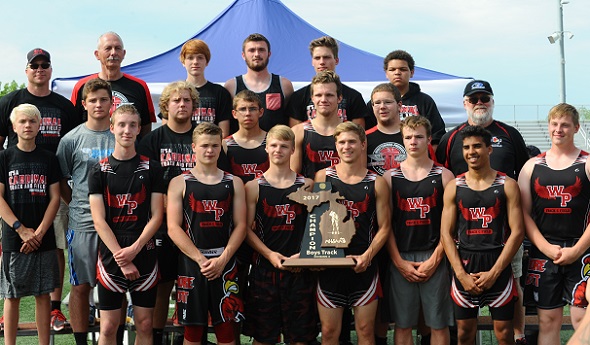
Cardinals Cap Unbeaten Season with 1st Title
June 12, 2017
By Geoff Kimmerly
Second Half editor
As coach Jeff Erickson searched the hallways for athletes to bolster his boys track & field team, he let them know up front this was not a sport where they’d get tons of attention and hype.
 This season, those 28 athletes instead earned an MHSAA Finals championship.
This season, those 28 athletes instead earned an MHSAA Finals championship.
With a few football players here, some basketball players there, and a boost from the cross country program started only four years ago, Whittemore-Prescott routed its Lower Peninsula Division 4 Regional opponents by 98 points and then claimed the Michigan Interscholastic Track Coaches Association Division 4 team championship over Memorial Day weekend.
Technically, those accomplishments earned the Cardinals the MHSAA/Applebee’s Team of the Month award for May. But it’s impossible to not also mention what Whittemore-Prescott accomplished the following weekend, on June 3 – the Cardinals won their first MHSAA Finals boys track & field title, by five points over Manton, and without an individual event champion.
“For a Division 4 school to be as deep as we were, we had kids come out this year that really helped us out and added to our depth,” Erickson said. “We had the banquet (last week), and I told the kids the difference between us and everybody else was our number two and number three (in each event). Everybody is going to have one or two good kids, and sometimes that’s enough to win a state meet … but we had our share of really good kids, and our key was our number two and number three.”
Whittemore-Prescott won every meet it participated in this season.
The 187 points scored at the Regional not only led to the large margin of victory, but were the most scored by a boys team at any Regional this spring. The Cardinals then won the MITCA team meet by 202 points with first place finishes in four events: junior Michael Eagen in long jump, junior Zane Aldrich in the 1,600 and by the 400 and 800 relays.
The MHSAA Finals are scored a little differently than MITCA’s team meet, taking more into account a team’s elite performances – but the Cardinals’ depth still showed through.
Although there were no individual winners, Eagen was second in the long jump, a half-inch out of first. Senior Azaiyah Bell took fifth in the 100 meters, and junior Bradley Lomason was sixth in the 400. Senior Hunter Kensa was seventh in the 800, and Aldrich was fourth in the 3,200. The 1,600 relay of senior Ian Driscoll, Bell, sophomore Ridge Schutte and Lomason took second, only a half-second back, and after the same group placed third in the 800 relay.
“I thought we had a chance to be very, very good, but believe it or not we lost a lot from last year,” said Erickson, referring to his team that finished sixth in LP Division 4 in 2016. “But teams lose kids every year. It’s really about trying to fill those voids and seeing into the future. We go after the (MITCA) team meet, because to be in the position (to win) you have to have three pole vaulters, three hurdlers, and that’s helped us to have that depth. We always try to have a back-up plan.”
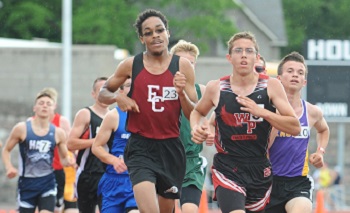 Erickson, a 1989 graduate of the school, also had an advance plan to build up the program – although all of the pieces fell into place perhaps more smoothly than could have been imagined and with a few beneficial surprises along the way.
Erickson, a 1989 graduate of the school, also had an advance plan to build up the program – although all of the pieces fell into place perhaps more smoothly than could have been imagined and with a few beneficial surprises along the way.
Groundwork was laid when Erickson started an offseason “Iron Club” for athletes from any program – for example, the softball team has been one of the biggest participants as Cardinals from all sports take advantage of another chance to put in extra work. Among those Erickson recalled recruiting to the Iron Club was now-senior Nick Stern, who won Regional titles this season in both the discus and shot put.
Another significant piece was the formation of the cross country program in 2013. Erickson, then the athletic director and track & field coach, was approached by then-sophomore Clayton Lange about starting the team. Erickson told Lange he’d do so and coach if Lange could find six classmates to fill out the roster with him – and when Lange did, Erickson and assistant Leroy Oliver got that program rolling.
In addition to Oliver, Erickson found more valuable help. Al Kushion joined his track & field staff after 31 years coaching at McBain. Doug Grezeszak, a MITCA Hall of Fame coach at Ogemaw Heights and Whittemore-Prescott alum, also came on to assist. Tim and Jody Yorton joined to instruct the throwers; Jody had been an All-American at Ferris State.
And Erickson’s contributions can’t be overstated. He originally took over the program on short notice while serving as athletic director in 2007 when his coach at the time was called into active military duty. Add in his roles in the formation of the cross country program and as a recruiter in the halls both for his team and the Iron Club. And then consider that this was his first school year not at the school – he moved on before last fall to the Clare-Gladwin Regional Education Service District, about an hour drive from Whittemore-Prescott.
That daily trip meant relying more on his assistants. It also meant pushing Iron Club later into the afternoon, which meant athletes often went home and came back to work out – and Erickson said this team was especially committed to doing so.
“It was kind of a unique story from the perspective of that, and the kids and what they were able to do,” Erickson said. “What the kids were able to accomplish, it was such a great thing.”
Past Teams of the Month, 2016-17
April: Frankfort baseball - Report
March: Flushing girls basketball - Report
February: Grand Rapids Forest Hills Central girls skiing - Report
January: Powers North Central boys basketball - Report
December: Dundee boys basketball - Report
November: Rockford girls swimming & diving - Report
October: Rochester girls golf - Report
September: Breckenridge football - Report
PHOTOS: (Top) Whittemore-Prescott’s boys track & field team stands together with its first MHSAA Finals trophy in the sport. (Middle) The Cardinals’ Zane Aldrich leads the pack during the 3,200 at the Lower Peninsula Division 4 Finals at Grand Rapids Houseman Field. (Photos by Dave McCauley/RunMichigan.com.)
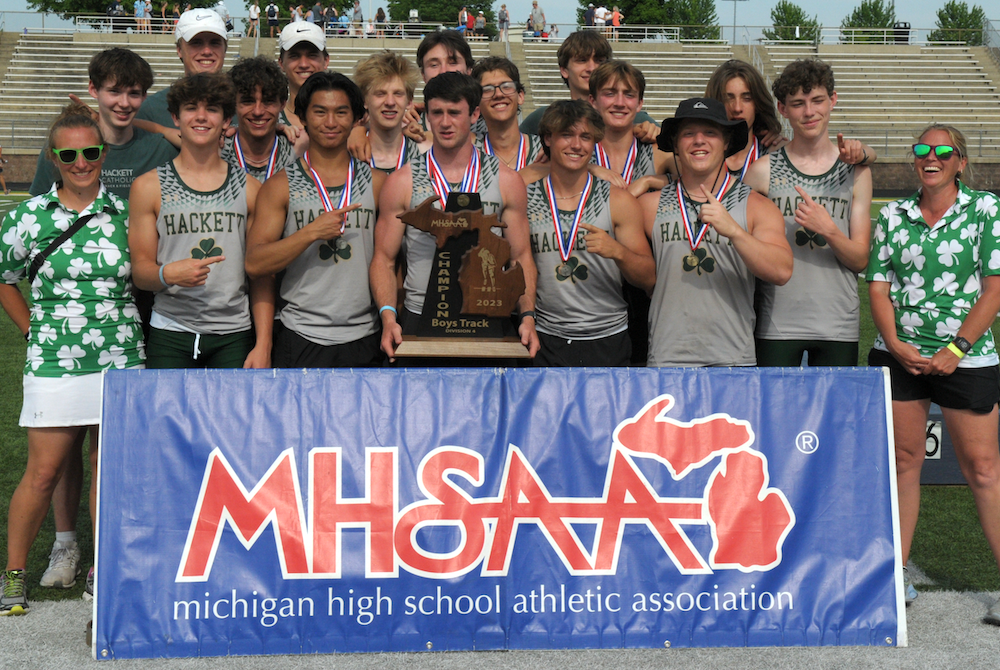
Thrower Claims Lone Individual Title to Lead Hackett to Team 3-Peat
By
Tom Lang
Special for MHSAA.com
June 3, 2023
Kalamazoo Hackett Catholic Prep just keeps winning and winning.
This time the Irish took home their fourth title in the last five Lower Peninsula Division 4 Track & Field Finals, on Saturday at Hudsonville.
Hackett’s only individual title was taken by discus winner Nathan Buchmann, a senior, who was fine knowing he was the shortest in stature among all the sizable competitors.
“In the offseason after football I worked out every day, working towards this goal,” he said after getting his medal. “I would say this takes 80 percent technique and 20 percent strength to throw the discus. So, length can help but if you have good technique and are really strong, that will play into it.
“I think we are very balanced throughout the meet today,” he said about teammates that scored points in finishes other than first place. “We have 13 guys here today, and we have people in a lot of the races. But I do not run; I have too short of legs to be a fast runner,” he said with a chuckle.
Buchmann had to work through a hip injury to compete this spring.
“I think the setbacks are what make you strong,” he said. “You can either give up through the setbacks or push forward and become better.”
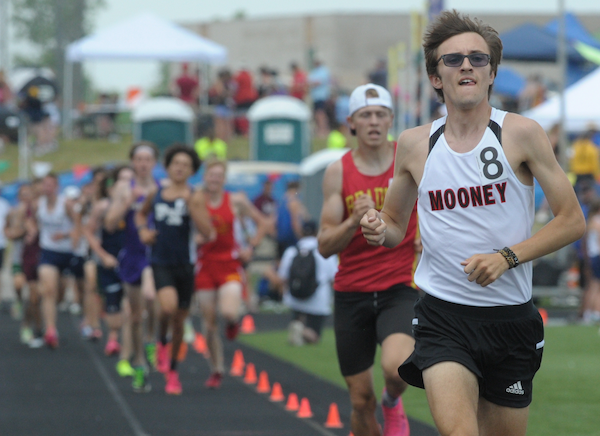 Coach Charissa Dean agreed.
Coach Charissa Dean agreed.
“The kids have big hearts,” she said after all the points were totaled and the Irish were on top once again, with 53. “They worked hard. They had a lot of potential when we started the season. And we had a lot of drive to put in the work, and we are happy the results came out the way they did.”
Reading was runner-up at 47 points, followed by Wyoming Potter’s House Christian with 42, then Fowler and Flint Beecher each with 37 points.
Senior Lezawe “Moses” Osterink, of Potter’s House Christian, placed second in 1,600 but took the 3,200 title as defending champ of both. He dominated the latter by lapping the field with a final lap kick that resembled more of a superhero speedster.
“Nobody really took it out that hard at the start,” he said. “There was a freshman (Marek Butkiewicz of Hackett) that tried to get the pace going quick, but me and Dakota (Dykhuis of Montabella) just kind of sat back and gradually pulled him through.
“We took it gradually, and I was just relying that I could kick.”
Kick did he ever. The trio were neck and neck the majority of the race in a grouping ahead of the pack.
“With 400 to go I just tried to go all out,” Osterink said. “I had a lot more left than I thought and I was pleased with the win. Not really the time, but that doesn’t matter, especially this hot out.”
The overall meet was in the low 90s/high 80s heat and searing sun all day. So, race officials allowed the unique opportunity for coaches to spray the runners with water and give them water bottles.
“It was very weird because I’ve never taken water to drink while I’m running, so I didn’t know how that would feel,” Osterink said. “And they were spraying us and hitting us in the face. It was kind of fun.”
Junior Tyler Lenn of Marine City Cardinal Mooney defeated Osterink at his own game in the 1,600.
“I’m feeling great,” Lenn said after grabbing the medal. “I said to a newspaper after one of my races (during the season) I was right where I wanted to be. This has been a long rebuilding process for me since an injury back in the fall, and I set a pretty high goal the day the injury happened. I was telling myself I needed to fulfill what I said I would do at the beginning of last cross country season. And that is what I did today.”
Lenn suffered an ankle sprain from a misstep that turned worse because he kept running through the season on it.
“Coming back from that was pretty tough, but I wouldn’t have it any other way,” he said. 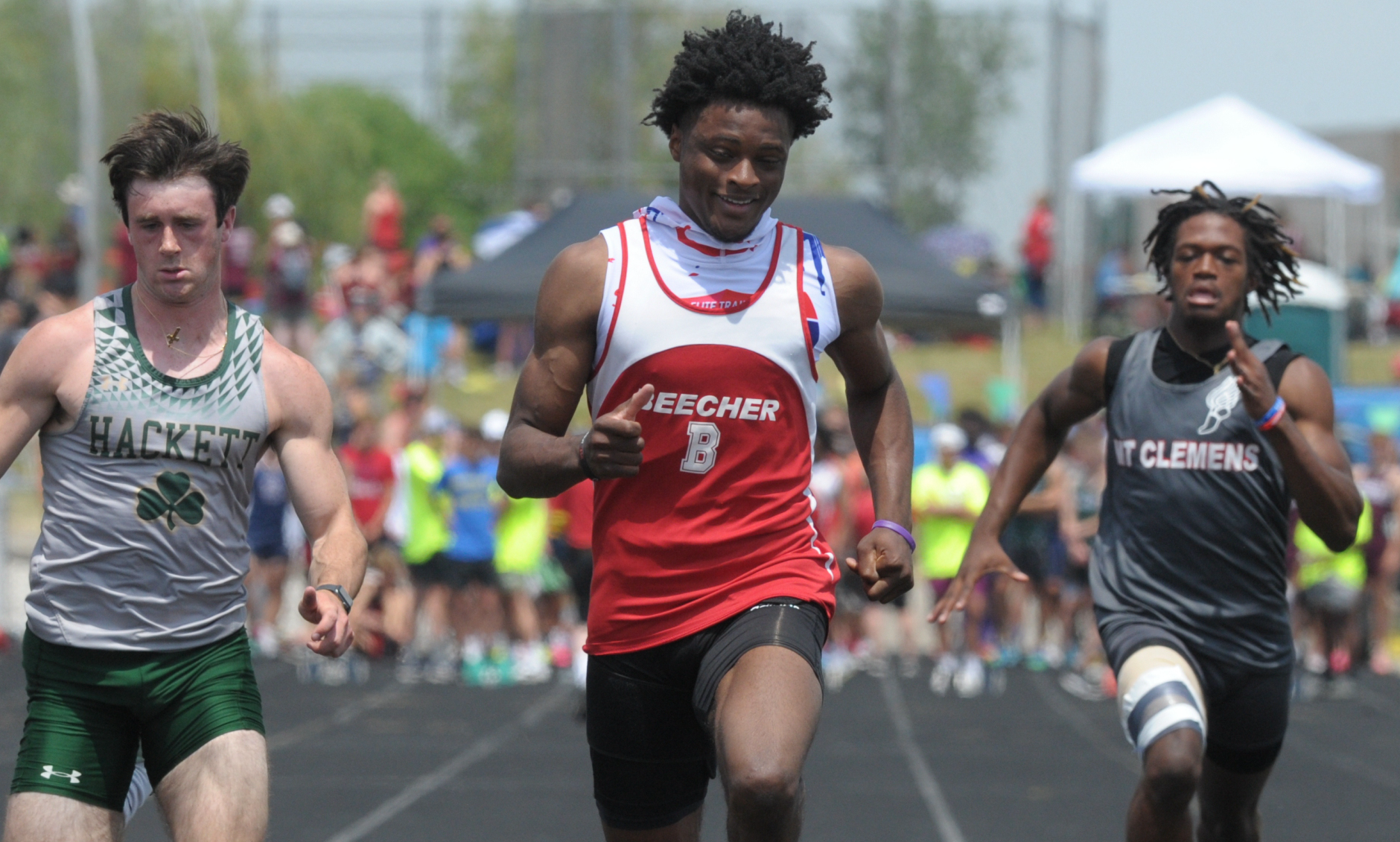 “Perseverance; I said from the beginning what I was going to do. I kept my eye on that target, and no matter the circumstances life threw at me, that I was going to make it happen and I am a man of my word.”
“Perseverance; I said from the beginning what I was going to do. I kept my eye on that target, and no matter the circumstances life threw at me, that I was going to make it happen and I am a man of my word.”
Jaylin Townsend, a senior from Flint Beecher, dominated the short races. He won the 100 dash (10.67) and 200 dash at 22 seconds flat. It was his third 100 win at a Finals.
“I put in a lot of work; I had to three-peat,” he said after the 100. “There’s a lot of great competition here, so I knew I had to come out and run my best.”
Concord in the 400 (43.72), Buckley in the 800 (1:30.76) and 1,600 (3:29.13) and Potter’s House in the 3,200 (8:14.18) were relay champs Saturday. Reading’s Tayshawn Bester won the 110 hurdles (15.13), and Athens’ Landen Bennett won the 300 (39.85). Caseville’s Nathan Feltner won the 400 (50.76), and Vestaburg’s Owen Patton claimed the 800 (1:55.11).
Fruitport Calvary Christian’s Bradley Richards won the high jump (6-10), and Peck’s Alex Affer won the long jump (23-4). McBain Northern Michigan Christian’s Isaac Bowden was first in pole vault (13-0), and Brown City’s Kyle Affer won shot put (49-2).
PHOTOS (Top) Kalamazoo Hackett Catholic Prep celebrates its third-straight LPD4 title Saturday. (Middle) Cardinal Mooney's Tyler Lenn, far right, sets the pace in the 1,600. (Below) Flint Beecher's Jaylin Townsend, middle, crosses the finish first for one of his two sprint championships. (Photos by Ken Swart/RunMichigan.com.)

